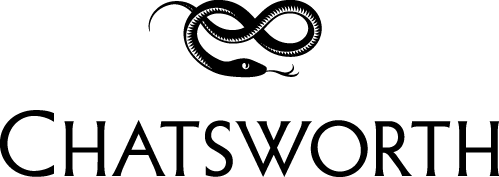I came to Chatsworth in March 2022 to undertake a project alongside my PhD studies into a 19th Century British Composer.
I'd heard from a researcher working at Chatsworth that there were two cardboard boxes in the archives simply labelled ‘music collection’. My curiosity sparked, I approached the archive team and we agreed that I would visit and explore those boxes, create a formal printed catalogue for them, and research the music they held, as well as other pieces preserved in the archives.
Quite a lot of the music in the collection doesn’t originate from Chatsworth, but one significant piece does and it was copied into a music book belonging to the 6th Duke, William Cavendish.
The book is, if you will, an iPod of the 19th Century. Before the age of recording, if you heard a piece of music and liked it, the only way to listen to it again later was to write it down.
The book is full of short pieces, mostly dances, that the Duke either wrote down himself or had others write down for him (there are three distinct handwritings in the book). The book is embossed ‘Hartington’ as in Lord Hartington, the name William Cavendish used before his succession to the Dukedom.
One composition is noted as being by ‘Lady Catherine Stewart’ (the wife of Charles Stewart, eldest son of the 2nd Marquess of Londonderry), and is entitled ‘The 21st of May. A Waltz’. As the 21 May 1811 was William Cavendish’s 21st Birthday, and two months before the death of his father and his succession to the Dukedom, it's reasonable to suppose that this piece was written to celebrate the occasion and most likely performed at the time.
'The 21st of May. A Waltz - by Lady Catherine Stewart. 1811' performed by Elizabeth French
The authorship and provenance of many of the pieces in the book are lost to history, they are simply labelled ‘Waltz’ or ‘Minuet’ but some have more detailed titles, such as this one, ‘from Figaro’. This piece does not appear in the modern version of Mozart's opera 'The Marriage of Figaro' that we know today but may have been added at a contemporary performance, as did occasionally happen.
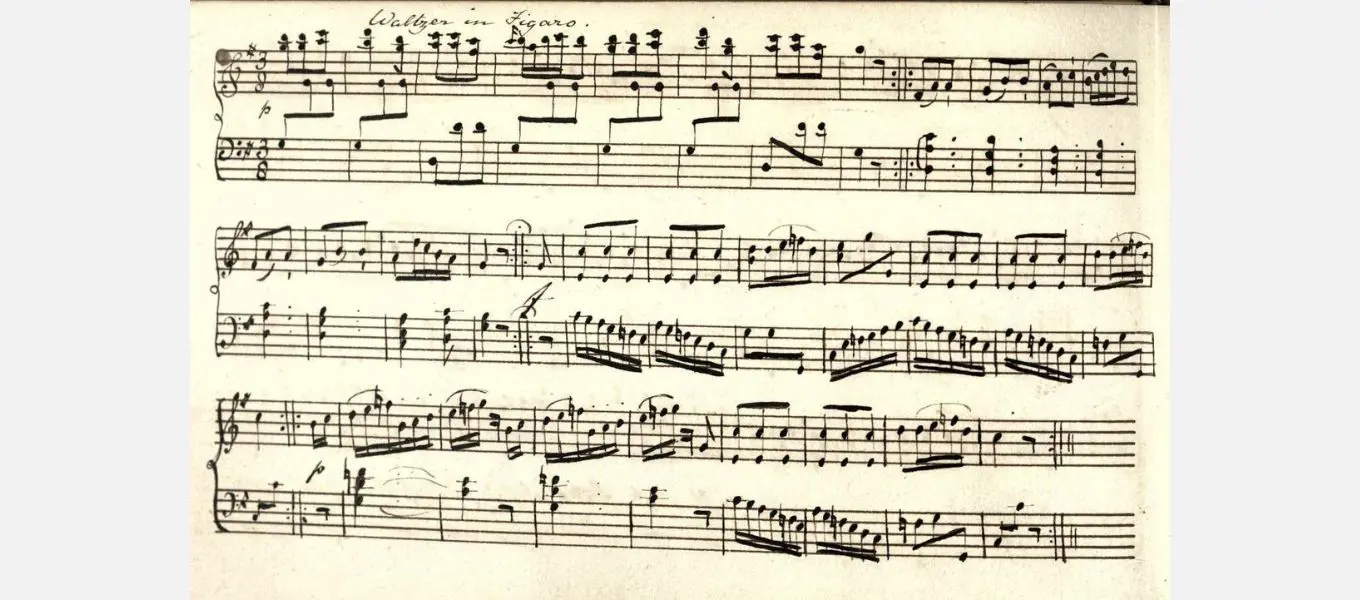
There is also a waltz ‘composed by H.R.H. the Princess Charlotte’, the daughter of George IV who had a fascinating and sad life story in her own right, dying in childbirth at the age of 21, but who was well known for her musicianship.
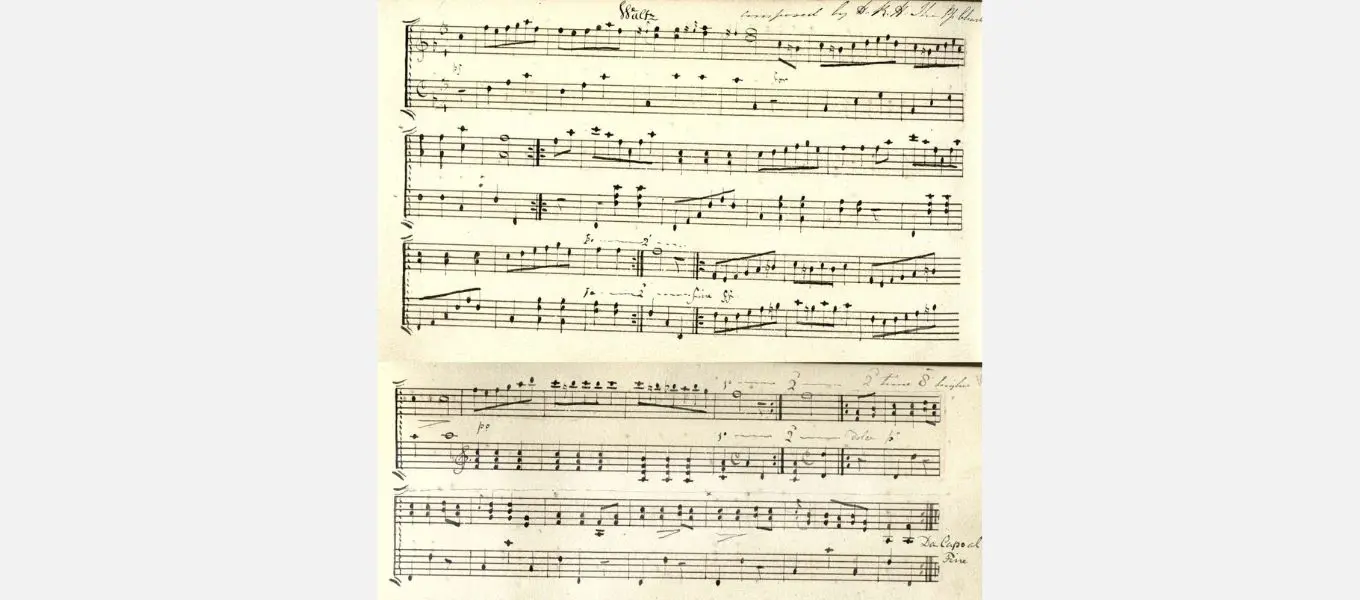
The 6th Duke was known to be a keen pianist and had his self-styled ‘personal pianist’, Charles Coote, play the piano for him at Hardwick Hall the evening before his death in January 1858.
While I was based at Chatsworth, I researched Coote and discovered that he was associated with Chatsworth and the 6th Duke for around 30 years. As well as leading the Duke’s private orchestra, he was ‘loaned out’ by the Duke on a number of occasions to the author Charles Dickens to play for various productions at venues across England.
Coote wrote the music for Sir Edward Bulwer Lytton’s comedy, 'Not So Bad As We Seem', which premiered at Devonshire House on 16 May 1851, with the Queen and Prince Albert in attendance. Read more about this performance in this blog.
According to John Forster, in his biography 'Life of Charles Dickens', it was then performed many times at the Hanover Square Rooms before touring the country ‘for considerable portions of this and the following year’. In April 1852, Charles Dickens wrote to the Duke of Devonshire to ask to ‘borrow’ Coote to conduct the orchestra, as Dickens believed him to be the right man to conduct local musicians.
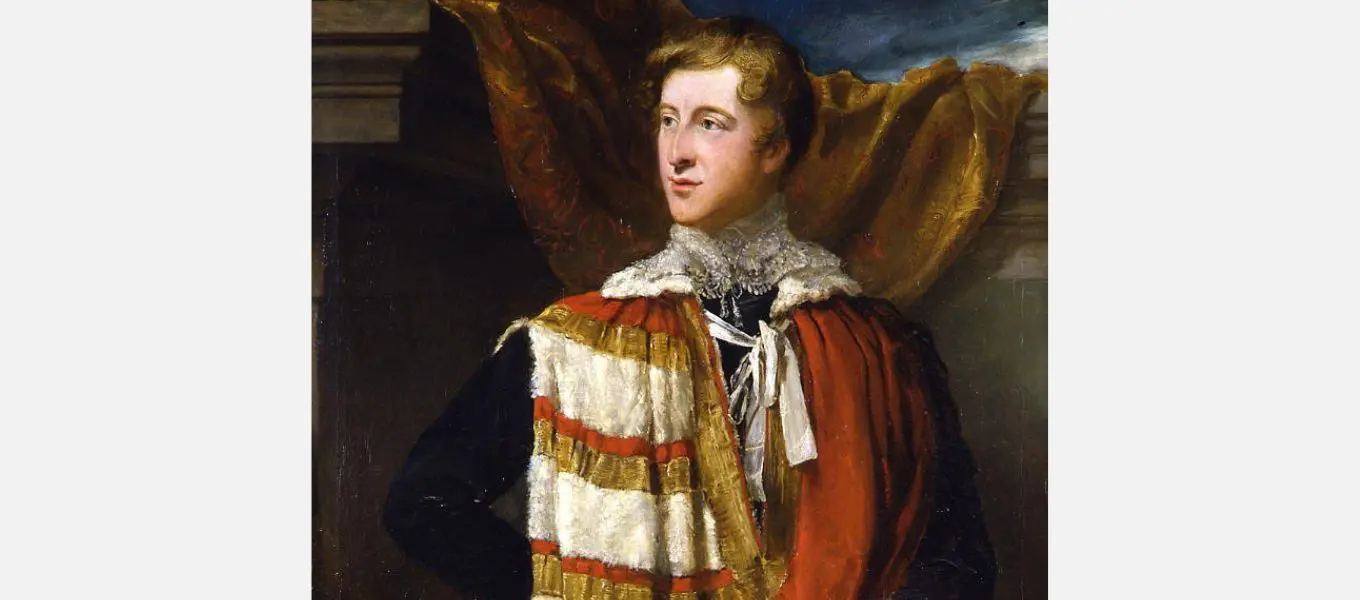
In the archive, there are a number of letters from Dickens to both the Duke and Charles Coote himself, discussing details of the trips that would be made to rehearse and perform the show.
Dickens is effusive about Coote; in a letter to the Duke dated 17 May 1852, he writes that ‘[Coote’s] usefulness has been greater than I can express. Instead of a band of hiccupping fiddles, maudlin flutes, and staggering instruments of brass, blaring on their own account into the air .. [he] has given us a charming orchestra drilled to their work in a couple of hours.’ And, always aware of to whom he is writing, Dickens adds ‘to crown all, he is associated with Devonshire House – and anything in that connexion comes like a cordial to every one of us.’
Charles Coote was a prolific composer, who wrote or arranged almost 200 pieces of music, including quadrilles, waltzes and other dance sets for band, as well as copious songs, short instrumental pieces, and incidental music for the drama.
The collection at Chatsworth does not hold a portrait of Coote (there is one in the V&A collection), but there is a tiny watercolour which shows a group of people in a drawing room, with a man playing the piano. The names of the people present are listed beneath the watercolour, and by going through the Duke’s diaries and the visitor logs for Chatsworth House, I was able to determine that the picture was painted by the Duke, from life, at some point in the first week of October 1829, when all the people listed were guests.
This is interesting because Coote, then aged just 20, had only recently met the Duke, in fact, the earliest mention of him playing at Chatsworth is just a month before this picture was painted, on 6th September 1829.
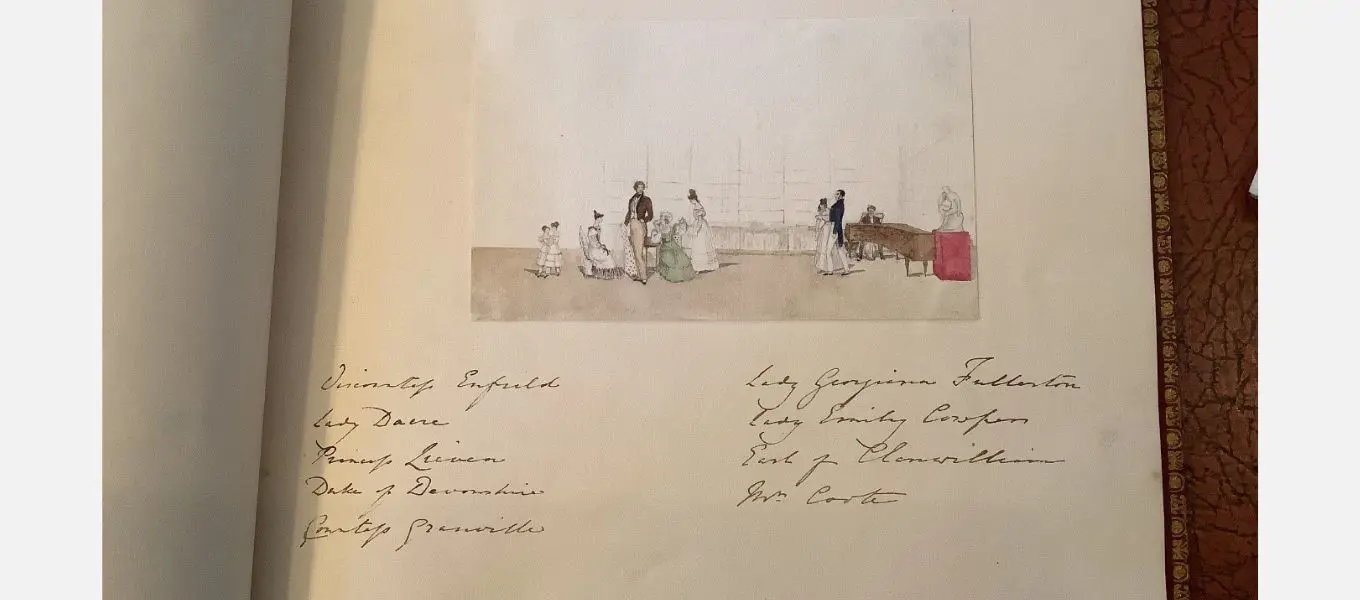
In 1843 Coote produced his Chatsworth Quadrilles on the occasion of Queen Victoria and Prince Albert’s visit to the house. Whilst the manuscript of the orchestral original is held in the Royal Collection at the British Library in London, the original printed version of the piano arrangement was in one of the cardboard boxes in the archives.
A Chatsworth Quadrille written by Charles Coote, performed by Elizabeth French
As an aside, Coote’s Quadrilles are not the only pieces of music named for Chatsworth. The now almost completely forgotten James J. Haffer wrote a series of ‘Chatsworth House Waltzes’, which were published in 1856 and dedicated to the 6th Duke of Devonshire.
So, what else was in those cardboard boxes? Most of the music belongs to the family of the 7th Duke. There’s a large amount of flute music, several books containing one part of flute duets, usually the second, which the Duke probably played as a young man, and some manuscript books of musical exercises.
Of course, there was also a lot of dance music, which isn’t surprising when we consider that the purpose of music at Chatsworth was for the education of members of the family but also, probably primarily, for entertainment.
Also in 'the box' was a book that I initially passed over; listed as ‘uncatalogued material’, the thin, brown-leather-bound book was yet another manuscript book, presumably put together by a member of the family.
The more I looked at it, the more I saw, very faintly, the letters ‘G.D.’ inscribed on the front cover. After looking through the family tree and searching for the date 1794, as seen on the title page inside, I realised that perhaps this was a music book belonging to Georgiana, Duchess of Devonshire.
The book dates from the 1790s, while Georgiana was travelling in Europe. Alongside versions of tunes she’d presumably heard in London and wanted to play, there are local melodies with dates that match up to letters she was writing at the time, from Italy, Austria, Belgium and France, including the Marseillaise, possibly notated prior to its adoption as the French national anthem because she entitles it ‘La Marche des Marseillois’ and the revolutionary song ‘Ca Ira’. There is also a piece entitled 'Austrian Retreat'.
'Austrian Retreat', performed by Elizabeth French
To me, this correspondence of date and music makes it clear that this volume was Georgiana’s, and the fact that we can trace the music that she was hearing as she travelled is exciting and will perhaps inspire another research project in the future.
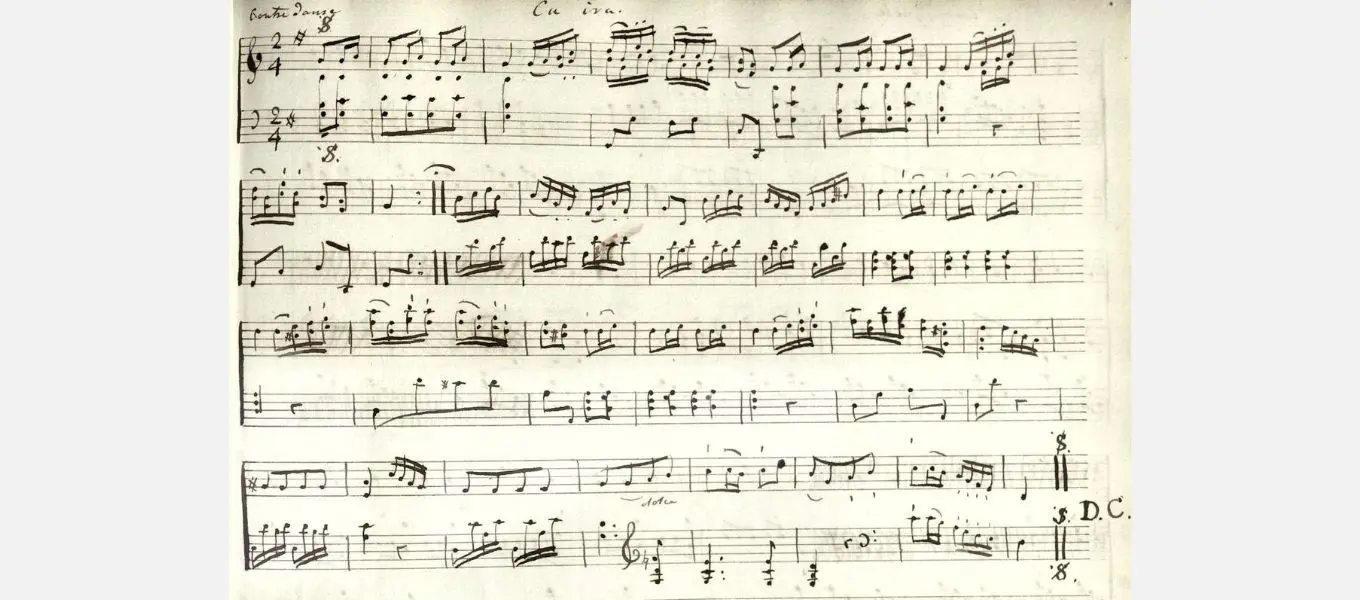
This blog is an extract from a talk given to Patrons of Chatsworth at an intimate musical evening held in the house in June 2023.
Find out more about our Patrons of Chatsworth scheme and other ways you can support the work of the Chatsworth House Trust charity by visiting the links below:
About Chatsworth House Trust
Chatsworth House Trust is a registered charity established in 1981 to improve and maintain the house, collections, garden, woodlands and park for the benefit of everyone.
Support our Cascade Campaign
The Cascade has been delighting visitors to Chatsworth since 1696 but is now in need of urgent repair. Learn more about our fundraising campaign 'Celebrating the Cascade'.
Donate online
If you can, support us by making a one-off or regular donation to the Chatsworth House Trust charity online.
Chatsworth Friends
Support the work of the charity while benefitting from unlimited visits, free tickets to events and discounts on shopping, dining and stays.
Gift Aid
When you use Gift Aid, the government gives an extra 25% on top of your kind donation, in lieu of tax you have already paid. All of this money goes directly to Chatsworth House Trust.
Patrons of Chatsworth
Patrons play a vital role in supporting the long-term stewardship of Chatsworth and enjoy exclusive access to the collections and curatorial team via special events.
